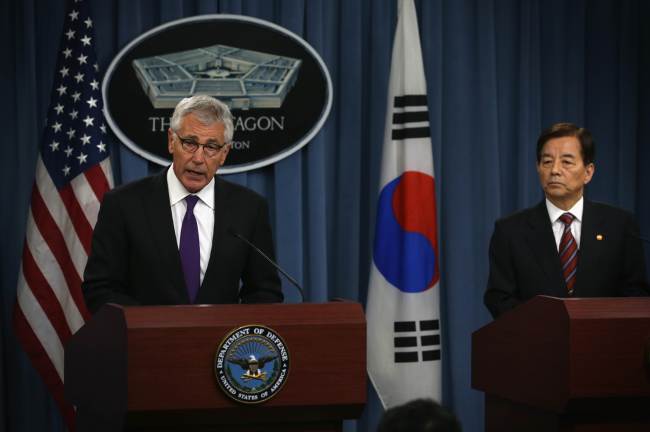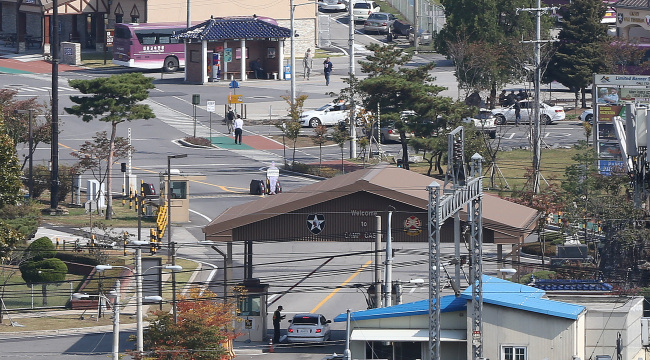South Korea and the U.S. agreed Thursday to a “conditions-based” transfer of wartime operational control in light of evolving North Korean threats, finalizing their decision to delay the transfer, previously scheduled for December 2015. They did not set a date for the transition.
The allies also agreed to station their Combined Forces Command in its current location in central Seoul until the OPCON transition, and retain the 210 Fire Brigade, the U.S.’ key counterfire unit, north of Seoul until the South’s artillery reinforcement plan is completed.
The allies also agreed to station their Combined Forces Command in its current location in central Seoul until the OPCON transition, and retain the 210 Fire Brigade, the U.S.’ key counterfire unit, north of Seoul until the South’s artillery reinforcement plan is completed.

These agreements were made during the annual Security Consultative Meeting in Washington, D.C., which was attended by Seoul’s Defense Minister Han Min-koo, U.S. Defense Secretary Chuck Hagel and other top officials from both sides.
At the SCM, the two defense chiefs did not fix a date for the transfer, but agreed that the South will assume OPCON when the South’s “critical” military capabilities are secured, and the security environment on the peninsula and in the region is conducive to a stable OPCON transition.
The two sides agreed that based on the SCM recommendations, the allies’ national leaders would make the final decision on the “appropriate timing” for the OPCON transition.
The critical capabilities for the South include its Kill-Chain preemptive strike and Korean Air and Missile Defense systems, which are designed to counter the North’s nuclear and missile threats. Minster Han said that the South would seek to develop the two systems by the mid-2020s, hinting that the OPCON transfer would be delayed until after then.
As the two sides agreed to another delay, they will work on developing a strategic document by next year’s SCM to replace the current “Strategic Alliance 2015,” a plan crafted to prepare for the 2015 OPCON transfer.
It was the second time that the allies have agreed to a delay. Initially scheduled for April 2012, the transfer was first postponed to 2015 in June 2010 after a series of provocations by the North, including the torpedoing of the South Korean corvette Cheonan that killed 46 sailors.
The second postponement came amid increasing security concerns in the South over North Korea’s growing military threats. Seoul officially requested last May that the allies rethink the timing of the transition in consideration of the North’s third nuclear test last February and its long-range rocket launch in December 2012.
To better deal with North Korea’s missile threats, the two sides reaffirmed their resolve to counter Pyongyang’s missile threats through the establishment of the “Concepts and Principles of the Alliance Comprehensive Counter-Missile Operations” ― a combined mechanism to detect, defend, disrupt and destroy missile threats including nuclear and biological warheads.
The decision to retain the CFC and its headquarters in the current location is expected to ensure smooth military cooperation between the allies, but could cause friction with local opponents who argue that the decision could hamper the construction of a public park in Yongsan-gu.
Seoul officials said that the CFC building, called the White House; the Command Center Seoul; and the building for the headquarters of the Eight U.S. Army will remain in their current locations. The land occupied by the three buildings are expected to take up less than 10 percent of the current Yongsan Garrison.
But the officials stressed that the allies’ basic goal is to prevent any disruption in the plan to construct the park.
As for the decision to retain the U.S. counterfire unit in Dongducheon, Gyeonggi Province, Minster Han said that Seoul’s plan to reinforce its artillery forces so they are capable of conducting a critical mission during the early phase of warfare is to be completed by the year 2020.

Local residents have expressed opposition to the decision. But Seoul officials said that the allies shared the view that should the 210 Fire Brigade be relocated, it would be difficult to promptly and effectively counter possible attacks by Pyongyang near the inter-Korean border.
The U.S. fire unit boasts powerful equipment including advanced multiple launch rocket systems, Army Tactical Missile Systems, AN/TPQ-36 and 37 radars, M1 Abrams tanks, M2 Bradley infantry fighting vehicles and around 2,000 troops.
During the SCM, the two defense leaders also urged the North to abandon all nuclear weapons and existing nuclear programs. They also underscored that the North should accept the practical value of the Northern Limit Line, a de facto inter-Korean sea border, which it has long disputed and repeatedly violated.
For the nontraditional security challenges in the space and cyberspace domains, the two sides agreed to step up bilateral cooperation through enhanced combined exercises and more active information sharing.
By Song Sang-ho
(sshluck@heraldcorp.com)
-
Articles by Korea Herald



![[Herald Interview] 'Amid aging population, Korea to invite more young professionals from overseas'](http://res.heraldm.com/phpwas/restmb_idxmake.php?idx=644&simg=/content/image/2024/04/24/20240424050844_0.jpg&u=20240424200058)













![[KH Explains] Korean shipbuilding stocks rally: Real growth or bubble?](http://res.heraldm.com/phpwas/restmb_idxmake.php?idx=652&simg=/content/image/2024/04/25/20240425050656_0.jpg&u=)

